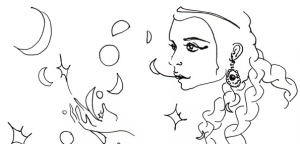The Philosophy Foundation has a track record of producing a kind of book that’s in short supply: truly innovative contemporary guides to teaching critical and creative thinking to children. Peter Worley’s Once Upon an If: A storythinking handbook – a companion to The If Machine and The If Odyssey – is a valuable addition to an exemplary series of books. It further equips teachers to facilitate philosophical enquiry in the classroom, using stories as a springboard for exploring challenging ideas.
The opening chapters of Once Upon an If offer a practical guide to storytelling and ‘storythinking’, while the remainder of the book is devoted to a collection of stories pitched to primary school children, accompanied by suggested discussion questions.
Dense with ideas, yet eminently clear and well-paced, Once Upon an If is replete with practical advice drawn from scholarly research, richly informed by classroom experience. Worley has an enviable way of elucidating ideas, and this book contains far more depth and subtlety than its 200-odd pages would suggest.
As the opening of the book reveals, stories can provide – beyond their sheer entertainment value – effective prompts for thinking. They can stimulate empathy, test the reliability of our intuitions, and provoke us to re-think our values. So, engaging with stories can be a fruitful way for children to rehearse for real-life situations.

“…children put together causal pictures of the world by creating fictional, possible worlds.” Illustration Tamar Levi.
The chapter on how to tell stories will interest anyone who cares to tap into storytelling as a way of engaging an audience’s attention and emotions. The storytelling techniques outlined here make perfect sense, and in retrospect many of them seem intuitively obvious – yet without the book’s explicit prompting, an inexperienced storyteller is unlikely to think of them, let alone employ them judiciously in the heat of the moment.
Worley begins by drawing the crucial distinction between reading a story and telling it, and then introduces a range of techniques to “lift the story from the page” – techniques for achieving the kind of spontaneous freshness and immediacy that breathes life into a story. We discover how to tell stories by heart, while avoiding mere recitation. We learn how to convey meaning unmistakeably without getting mired in lengthy descriptions. We pick up strategies for involving audience members in a story and activating their imaginations. We’re invited to consider how the audience’s sympathies can be shaped by the storyteller’s choice of tense and narrative point of view, and how characters’ motivations can be made vivid and believable in the telling.
There’s specific advice on the nuts-and-bolts of storytelling such as breathing patterns, eye contact, pacing, vocal tone, dynamic variation, gesture and movement. These techniques help to demystify what often appears to be a magical art: telling a compelling story with improvisational fluency and confidence.

Storytelling produces “a wow-factor … to really hook them before the philosophy begins.” Illustration Tamar Levi.
The chapter on ‘storythinking’ offers a toolkit of practical strategies for using stories as flint to spark students’ critical and ethical thinking. While this chapter recapitulates many of the ideas from previous books in the If series, it will serve as a useful primer for those new to teaching thinking, or as a neat refresher for the more experienced. There’s no shortage of examples to illustrate how the strategies can be used to stimulate conceptual thinking and to foster collaborative dialogue about controversial issues.
Worley presents elements of logical thinking (such as conditional reasoning, justification and hypothesis testing) in a straightforward and accessible way. His suggested methods for introducing these in the classroom are sensitive to group dynamics and responsive to children’s cognitive and moral development.
There’s a strong focus on cultivating children’s intellectual autonomy. The storythinking strategies encourage children to formulate their own arguments in support of their beliefs, and to try resolving ethical dilemmas for themselves. Worley shows teachers how to pivot deftly from the concrete details of plot and character to more abstract levels of enquiry, all the while treating the story’s moral as contestable.

“…stories can be used to create controversies with which children can then think more deeply.” Illustration Tamar Levi.
In the first half of Once Upon an If we encounter a typology of stories – and in the second half, fleshed-out examples of many of these story types. They include tales based on historical events, plausible fictional narratives, and thought experiments designed to stretch the imagination into the domain of the hypothetical. There are also myths and legends, fables and parables, tall stories and anecdotes, tales with a twist, and self-referential stories. We discover how each of these story types may be presented in a range of formats – such as dialogue, verse or ‘what-if’ scenarios – to differing dramatic effect.
The book includes more than two dozen stories – originals and adaptations – ready for the telling, accompanied by philosophical questions to spark hundreds of conversations. There are also several extension activities, including structured creative writing tasks and research projects to assign to students, as well as classroom demonstrations and games. Completing the package are online supplementary materials and recommendations for further reading.
This meticulously planned, helpfully cross-referenced and readily digestible book would be a welcome addition to the library of any primary school teacher, storyteller or dialogue facilitator. I’m left with the distinct impression that we can all learn to spin a good yarn and use it to draw out the philosopher in every child.
![It was as if I had cast a magic spell… Storytelling [has] never failed yet to engage and stimulate.” Illustration Tamar Levi](https://thephilosophyclub.files.wordpress.com/2014/09/open-book.jpg?w=300&h=190)
“It was as if I had cast a magic spell… Storytelling [has] never failed yet to engage and stimulate.” Illustration Tamar Levi.
The Philosophy Club runs co-curricular and extra-curricular workshops for children in Australia. The Big Questions philosophy mentoring program is our flagship in-school program.

